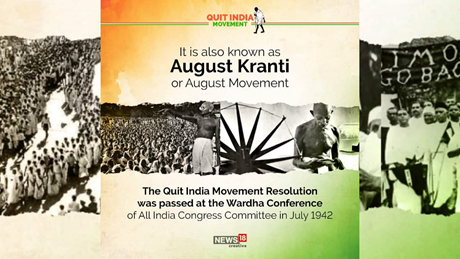

9th August 2022 (8 Topics)
Context
On August 9, 1942, the biggest mass movement of the Indian freedom struggle was launched.
About
- August 8, 2022 marks the 80th anniversary of the Quit India Movement.
- The Quit India Movement Resolution was passed at the Wardha Conference of All India Congress Committee in July 1942.
- The movement was launched at the Bombay session of the All India Congress Committee by Mahatma Gandhi on August 8, 1942.
- The slogan ‘Quit India’ was coined by Yusuf Meherally who was a socialist and also a trade unionist.
- A few years ago, in 1928, it was Meherally who had coined the slogan “Simon Go Back”.
- Gowalia Tank Maidan also known as August Kranti Maidan, in Mumbai is the place where Gandhi delivered his speech marking the beginning of the movement.
- Several national leaders were arrested, among them were Mahatma Gandhi, Abdul Kalam Azad, Jawaharlal Nehru and Sardar Vallabhbhai Patel.
- The event was followed by an uproar among the people and the emergence of several young leaders such as Ram Manohar Lohia, Jai Prakash Narayan, SM Joshi, and others who continued to fuel the fire of the movement throughout India during the period of World War II.

Quit India movement: History
- On 8 Aug 1942, Mahatma Gandhi gave a clarion call to end British rule and launched the Quit India Movement at the session of the All-India Congress Committee in Mumbai.
- Although the movement was suppressed by 1944, it played an important role in uniting the common people across the country against British rule.
Quit India Movement: Provisions
- The immediate end of British rule in India.
- Declaration of free India commitment to defend itself against all kinds of imperialism and fascism.
- After the withdrawal of the British, the formation of a provisional government of India.
- Sanctioning a civil disobedience movement.
Quit India Movement: Gandhi’s Instructions
- Government servants were instructed not to quit their job but to proclaim loyalty to Indian National Congress.
- Soldiers were instructed to continue being with the army but refrain from firing on compatriots.
- Peasants were instructed to pay the agreed-upon rent only to the anti-government Zamindars/landlords, if there were pro-government, no rent should be paid.
- Students were instructed to leave their studies only if there were confident enough.
- Princes were instructed to support the people and accept their sovereignty of them.
- People of the princely states were instructed to support their ruler only if he was anti-government.
Quit India Movement: Immediate Cause
Immediate cause for Quit India failure of Cripps Mission was Stafford Cripps that was sent to resolve the Indian question regarding new constitution and self-government. Cripps Mission failed because it did not offer complete freedom to India. It was for ‘Dominion Status to India’ along with partition.
|
Personalities Associated with Quit India Movement during British India
He planned an all-out campaign to compel British withdrawal from India, after the failure of the Cripps Mission to reach a compromise. At the historic August meeting at (Tank in Bombay, Gandhi proclaimed his mantra- do or die'. He was arrested on August 9, 1942. He undertook a 21 day fast in February 1943 to protest against the Government actions against Indians involved in the movement.
He was a member of the Congress Socialist group and played a prominent role in the movement.
They were leaders associated with the underground movement and revolutionary activities in support of Quit India Movement.
He called himself a Gandhian, formed a parallel government and captured all the ten police stations in Ballia, in east UP in August 1942.
She actively supported the movement and was an important member of a small group which ran the Congress Radio. Jawaharlal Nehru initially supported the arch Moderates, who was opposed to Gandhi's plan, but later, he moved the Quit India Resolution on August 8, 1942.
She helped Achyut Patwardhan in his underground activities. She later became India's leading woman industrialist.
She was a 73-year-old peasant widow in Tamluk, was killed in violence on September 29, 1942, when the Sutahata police-station was captured. Matangini kept the national flag aloft even after being shot.
He was an illiterate villager, led a large tribal population from Koraput to protest against the Jeypore zamindari and attack police-stations. Lakshman Naik was hanged on November 16, 1942 for allegedly murdering a forest guard. |
More Articles

